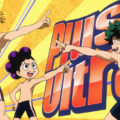Caligula– A Show about the Roman Emperor Would’ve Been Better

My initial reaction to the first episode of Caligula was “What the hell did I just watch?” I walked away extremely confused and it took five subsequent episodes to some shed light on that confusion. I’ll get more into the oddities later, so let’s start at the basics for now. Caligula is not about the depraved Roman Emperor, but is instead based on the 2016 PS Vita game, The Caligula Effect. In fact, this anime was little more than a promotion of the upcoming PS4 port. The game itself features writing by Tadashi Satomi who worked on the original Persona game, and the Persona 2 duology. Going into Caligula, I expected themes similar to Persona, what I got what was a major disappointment. There are shared surface level psychology elements and character building attempts. Those shared elements weren’t enough to stave off uneven plot pacing, dull characters, and generally bad writing.
Ritsu Shikishima is a high school student who loves psychology and philosophy in the same way other kids would love movies or video games. He enjoys his idyllic high school life, his good friends, beautiful music, and tasty food. Even though he’s living a great life, Ritsu can’t help but ponder about the nature of the humane psyche and how it affects his life. One of his favorite topics is the nature of the Johari Window, a technique that helps people to fully understand the relationship they have with themselves and others.

One day Ritsu’s ideal life is shattered when he hears someone begging for help inside of the virtual pop idol, μ’s song. (μ is pronounced “Mu.”) He asks his friends about it the next day and they brush him off until he plays the song for them. It instantly has the effect of causing everyone to stop and turn in unison to stare at Ritsu. Just as suddenly, a bunch of them begin to attack a senior student named Shogo Satake (aka Shogo the Fighter), who effortlessly takes on the group and wins. No one asks about the incident and Ritsu begins to notice that something isn’t right about the world. People seem to move unnaturally and time seems to repeat itself. Things come to a head at the class entrance ceremony when Ritsu doesn’t recognize the class representative. He’s not the only one and other students also begin to share their horror and confusion. Suddenly, μ appears and begins to sing, causing several students to transform into monsters and attack. Ritsu along with a few other students escape the gym where they are saved by Shogo who’s now sporting an enormous revolver. He shoots the monsters, making them collapse. Ritsu calls Shogo a murder and demands an explanation.
I came into Caligula expecting a Persona-like series. Instead, I walked away confused and feeling like this was instead a The Matrix-style series with psychological jargon tossed in as an attempt to make the show sound smarter. While I could respect director Junichi Wada’s attempt to keep the confusion up and let more curious viewers piece together the mysteries behind Caligula, the eventual unraveling of the mysteries wasn’t worth the initial confusion. It takes roughly four episodes before the true nature of the world is revealed. Yes, the people (not just students) are trapped in a virtual world called Mobius via VR headsets that leave them comatose in real life, but it is unclear just how many people are trapped. Let that sink in for a moment. People are being held captive in virtual world controlled by an idol named μ who is similar to Hatsune Miku. She just wants everyone to be happy and forget about their real world problems by living out their days as if they’re still in high school.

Ritsu and other characters who awakened to the false world wander around unsure of what to do until they band together forming the “Go-Home Club” for safety and a desire to return to the real world. The people who they interacted with in the city are revealed to have been nothing but bits of data taken from their memories. Other students (the ones who turned into monsters called DigiHeads) are also trapped, but are under the control of μ. There is a group of people working in collaboration with μ called the Musicians; they know this world is false, but have no desire to leave. Finally, there are people who don’t belong to the Go-Home Club or the Musicians and don’t know the world is false. They are literally unable to see the truth.
Members of the Go-Home Club are considered rogues because they can’t be controlled by μ and have awakened a “Catharsis Effect” that is similar to the DigiHead’s ability to turn part of their bodies into weapons. This power allows them to fight back and oppose Mobius. Unfortunately, it took five episodes for the main characters, besides Shogo, to manifest their powers. The Catharsis Effect has a buildup and release similar to Persona, but since the characters themselves aren’t developed beyond a strong desire to return home, the emotional payoff is nonexistent. It especially falls flat with Ritsu who is the last to waken to his Catharsis Effect, but unlike anyone else doesn’t have memories of home or even a desire to return. Instead he gains tremendous power because it simply dawns on him that a world like Mobius shouldn’t exist.

Speaking of the rest of the cast, the members of the Go-Home Club have their Catharsis Effect before we learn more about them. The character development is so shallow and its pacing is so jarring that it is hard to care when tragic backstories are revealed. Their stories range from the mundane such as Suzuna Kagura being a socially withdrawn bookworm, the outgoing Kotaro Tomoe wanting to become a rescue worker, Naruko Morita eventually becoming an online troll after trolls personally traumatized her, to Kensuke Hibiki to not having any talent to achieve a dream, but finding it in Mobius as a Musician before ultimately joining the Go-Home Club. Other stories should be more alarming such as Mifune Shinohara’s problems with body image and anorexia, Izuru Minesawa’s issue with self-agency and self-harming as a way to achieve said agency, Kotono Kashiwaba’s hatred of men and by extension her abuse and neglect of her young son, to Shogo becoming a NEET because he failed to join a friend in a suicide pact. Instead, these horrifying stories hit with the emotional impact of going grocery shopping. I even had to look up these characters’ names because they had so little impact on me that I couldn’t remember them. Yet, as audience members we’re expected to care about them.
Surprisingly, Caligula handles the Musicians slightly better. The show attempts to flesh out the Musicians by making them less black and white evil, and more of people who found the life they’ve always wanted in Mobius and will do anything to protect their power and freedom. Some of their stories unfold in a more natural way, and had more impact than the heroes’ because of the sheer hypocrisy of their actions versus their ideals. Other Musicians actions did come off as cartoonishly evil because of their desire to destroy everything as revenge for the lives they couldn’t live in the real world.

While I know the characters weren’t given enough time or room to be fleshed out, I’m not sure if more episodes would have been the answer. It felt like Wada spent so much time trying to build a mysterious world and unravel the truth behind that world, that the characters were only an afterthought. We had forced moments of interaction between the characters in the form of slice-of-life moments which didn’t work. A deeper look into the Go-Home Club’s lives before deciding to come to Mobius, and then them finding the resolve to face their problems as they trigged the Catharsis Effect would have been great character development.
The story and plot of Caligula actually had the potential to be good. At its core the show is a story about people who ran away from their problems and willingly sought out Mobius. Those who worked in collaboration with μ were allowed to keep their memories from the real world as they actively sought order, revenge, fame, and fortune in Mobius. On the flipside, the people who regained their memories of the real world, or just felt something was off with Mobius eventually discovered a desire to no longer run from their problems. They learned that in order to grow as people they needed to fix their mistakes no matter how painful their lives were.

As for μ, she was software engineered by well-meaning company. She kept her genuine desire to make people happy no matter what, but as μ’s power grew her ideals became twisted and caused people to go comatose in the real world. The psychology terms used do come into play for the final episodes, and the effect of Mobius in the real world is revealed, so at least the show doesn’t leave any plot threads untied.
Production-wise, Satelight failed in numerous ways. The first episode looked decent, but the animation quality dropped quickly. Characters frequently look off-model. The color palette is too muted as if someone thought desaturating everything was a good idea. The action scenes feel like a rote adaptation of a video game and are often boring (a problem actually shared with Persona 5 the Animation). On the upside, μ’s pop songs were a fun listen and felt relevant to the story.

Ultimately, I can’t recommend Caligula because of its numerous problems. If this adaptation was supposed to get an audience excited for The Caligula Effect: Overdose on PS4, it does a poor job. I can’t speak for the 2016 Vita game as I’ve never played it, but gamers liked the story and hated the buggy gameplay. This suggests that The Caligula Effect actually tells the best version of this story. A story the animated adaptation failed to live up to. As a result, I want even less to do with any version of the game and I don’t think I’m the only person who feels this way. It’s a shame because in more competent hands Caligula could have been a nice alternative to the sometimes lukewarm Persona 5 anime. Instead, it’s just a disappointing mess that will quickly be forgotten.
Images courtesy of Marth’s Anime Blog.





